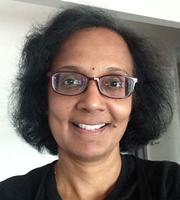When you drop a pebble into a body of water, the force creates circular ripples that gradually spread out across the surface. When an economic shock or crisis hits, the global economy is no different.
Any change, no matter how big or
small, can have far-reaching consequences, sending shockwaves around the world.
What follows could plunge a country further into debt, and affect the amount of
government spending for social good.
“In today’s global economy, everything is connected,” said Dr Mala Raghavan from the Tasmanian School of Business and Economics.
Dr Raghavan studies the spread of monetary, financial, and trade shocks on small, emerging, and open economies.
Using economic models, she’s able to predict the spread of various economic shocks within and across economies, and assess the potential outcomes.
These models are designed to give decision-makers in the economic sphere a better understanding of the nature of a shock and its effects.
The spill-over warning
The growing influence of emerging Asian economies since the 1990s has particularly caught Dr Raghavan’s attention, and she’s now focussing on countries such as Indonesia, Malaysia, the Philippines, and Thailand, as well as Hong Kong, South Korea, Singapore, and Taiwan.
“These economies are very vulnerable to external shocks. What’s important for us to identify is what’s driving these shocks, and how they penetrate through Asian economies,” Dr Raghavan said.
The global economy’s centre of gravity is shifting closer to Asian economies. What happens in Asia matters, because whatever’s happening there will impact on other countries.
Dr Raghavan says shock events originating from Asia would no doubt spill over to Australia – a country with strong trade links to the region.
To ensure that we’re better prepared for the shocks to come, Dr Raghavan has been working with her team at the University of Tasmania to better understand each Asian country’s economic past.
The first step of the process involves digging into over 20 years of statistics from the World Bank and International Monetary Fund.
Next, they follow the ripple of funds and investments, and backtrack to the particular behaviours that drove certain economic decisions along the chain.
As Dr Raghavan points out, every detail here counts.
Statistical models are then used to extend this information into the future, to reveal the estimated force of the economic shock.
No ‘one-size-fits-all’
When the 1997 Asian economic crisis that gripped much of South-East Asia hit, the International Monetary Fund stepped in to help countries in need.
But they made the mistake of giving a similar recommendation to each country, and in the end, it did more harm than good.
For that reason, Dr Raghavan and her team aren’t interested in a ‘one-size-fits-all’ prediction model – it's all about building tailor-made models for individual countries.
An intriguing picture Dr Raghavan has already highlighted through her models is Malaysia’s unique set of risks. Malaysia has a high level of foreign investment, but there’s a catch – many of these investments are short-term capital flows. This means as readily as foreign investment goes into Malaysia, it could just as easily dissipate.
Dr Raghavan’s method for predicting the force of shocks has caught the attention of the Central Bank of Malaysia, which has added it to their portfolio of models.
She’s currently working on new models to cover most of South-East Asia, and one of her PhD students is now focussing on the Middle East. Another student has successfully analysed the ‘Four Asian Tigers’: Hong Kong, Singapore, South Korea, and Taiwan.
Dr Raghavan hopes to eventually move on to some of the great economic engines of the world: China and India.
The ultimate message from her unique economic models, she says, is that each country has different economic behaviours, and their histories provide a cautionary tale that cannot be ignored.
Interested in conducting your own research? Apply now to become a research student.
Find out more about studying Business and Economics here.
